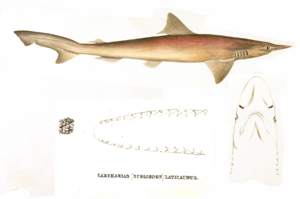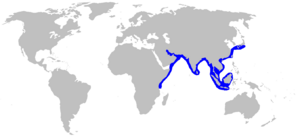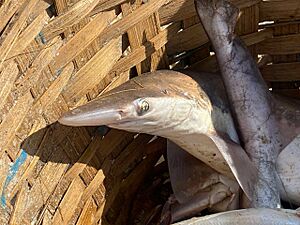Spadenose shark facts for kids
Quick facts for kids Spadenose shark |
|
|---|---|
 |
|
| Conservation status | |
| Scientific classification | |
| Genus: |
Scoliodon
|
| Species: |
laticaudus
|
 |
|
| Range of the spadenose shark | |
| Synonyms | |
|
Carcharias muelleri J. P. Müller & Henle, 1839 |
|
The spadenose shark (Scoliodon laticaudus) is a type of requiem shark. It belongs to the Carcharhinidae family. You can find this shark in the warm waters of the Indian Ocean and the western Pacific Ocean. It often swims in large schools in shallow areas.
This small shark grows up to 74 cm (29 in) long. It gets its name from its unique, flat, triangular snout, which looks like a spade. The spadenose shark hunts small bony fishes and other sea creatures like invertebrates. This shark has a very special way of giving birth. Its developing babies form a complex connection, like a placenta, with the mother. Females can have babies all year round. They give birth to 6 to 18 pups after being pregnant for 5–6 months.
The spadenose shark is safe for humans. People who fish for a living value it for its meat and fins. It is very common, so it's an important catch for many fisheries in South and Southeast Asia. The International Union for Conservation of Nature says this species is Near threatened. In Goa, India, this fish is also called mori.
Contents
About the Spadenose Shark
The first scientific description of the spadenose shark was written in 1838. Two German biologists, Johannes Peter Müller and Friedrich Gustav Jakob Henle, published it. The original shark specimen used for this description was about 42 cm (17 in) long. It is now kept in a museum in Berlin.
The name Scoliodon comes from Greek words. Skolex means "worm" and odon means "tooth". The second part of its name, laticaudus, comes from Latin. Latus means "broad" or "wide" and cauda means "tail". People also call this shark by other names. These include the Indian dogfish, sharp-nosed shark, trowel-nose shark, and yellow dog shark.
Scientists study how different animals are related. They believe the spadenose shark is one of the oldest types of sharks in its family. It is related to the Rhizoprionodon genus and the tiger shark. Some features also suggest it is closely related to hammerhead sharks. Hammerheads developed from other sharks millions of years ago.
What Does the Spadenose Shark Look Like?
The spadenose shark is a small and sturdy shark. It has a wide head with a very flat, trowel-shaped snout. This snout is one of its most noticeable features. Its eyes and nostrils are small. The corners of its mouth are far back, behind its eyes.
This shark has many rows of teeth. There are about 25 to 33 rows in its upper jaw. Its lower jaw has about 24 to 34 rows. Each tooth is thin and blade-like. It has a single slanted point and no jagged edges.
The first dorsal fin (the fin on its back) is closer to its pelvic fins than its pectoral fins. The pectoral fins are very short and wide. The second dorsal fin is much smaller than the anal fin (the fin near its tail). There is no ridge between its two dorsal fins. The shark's back is a bronze-gray color. Its belly is white. Its fins are usually plain, but they might be a bit darker than its body. The largest spadenose shark ever recorded was 74 cm (29 in) long. Some reports say they can grow up to 1.2 m (3.9 ft), but this has not been confirmed.
Where Spadenose Sharks Live
The spadenose shark lives in the western Indo-Pacific region. You can find it from Tanzania all the way to South and Southeast Asia. Its range extends east to Java and Borneo, and north to Taiwan and Japan.
These sharks usually live near the coast. They prefer water that is about 10–13 m (33–43 ft) deep. They often stay close to rocky areas on the seafloor. People have often seen this shark in the lower parts of rivers in Malaysia, Sumatra, and Borneo. However, scientists are not sure if it can live in fresh water like the bull shark. This is because there isn't enough information about the saltiness of the water in those river areas.
Spadenose Shark Life and Habits
Spadenose sharks are very common in many places. They often swim together in large schools. They mostly eat small bony fishes. Their diet includes anchovies, codlets, burrowing gobies, and Bombay ducks. Sometimes, they also eat shrimp, crabs, cuttlefish, and stomatopods.
This shark has a very advanced way of giving birth. It is called placental viviparity. This means the babies grow inside the mother and get food and oxygen through a special connection, similar to a human placenta. When the eggs are first released, they are only 1 mm (0.039 in) wide. The developing babies start depending on their mother for food when they are only 3 mm (0.12 in) long. The connection between the mother and baby is very complex. It has many tiny blood vessels. This allows a large area for gases to be exchanged. Nutrients are also passed from the mother's blood to the baby through a unique structure in the womb.
Female spadenose sharks likely mate at least once a year. They can breed all year long. The babies grow inside the mother for 5–6 months. When they are born, they are about 12–15 cm (4.7–5.9 in) long. A mother shark usually gives birth to 6 to 18 pups at a time. Male sharks become ready to have babies when they are 24–36 cm (9.4–14.2 in) long. Females are ready when they are 33–35 cm (13–14 in) long. They might become mature between 6 months and 2 years old. Males can live for about 5 years, and females for about 6 years.
Spadenose Sharks and People

The spadenose shark is not dangerous to humans. This common shark is caught by both small-scale and large-scale fisheries. Fishers use different methods to catch them. These include gillnets, longlines, bottom nets, fish traps, trawls, and hook-and-line fishing.
The shark's meat is eaten or used as bait for other fish. Its fins are valuable for shark fin soup. The rest of the shark can be made into fishmeal. The meat can also be processed into a gel powder. This powder can be used as a protein supplement in foods like cereal. It can also be made into a biodegradable film for wrapping seafood. Or it can be used as a binder in sausages and other foods.
Even though this shark is important for fishing, we don't have complete numbers on how many are caught. A report from 1996 said it was the most common coastal shark sold in Chinese markets. Many are caught by fishers in India and Pakistan. For example, from 1979 to 1981, about 823 tons were caught each year off Verval, India. Spadenose sharks are also caught by accident. This often happens in gillnet fisheries near Kalimantan.
The International Union for Conservation of Nature has listed this species as near threatened. This means it could become threatened in the future. Because this shark has a relatively short breeding cycle, it might be able to handle fishing better than some other sharks. However, it doesn't have many babies at once, so we still need to be careful. Also, building near the coast might harm these sharks. This is because they prefer to live in shallow waters close to shore.
Images for kids
-
Caught in Goa, India.



